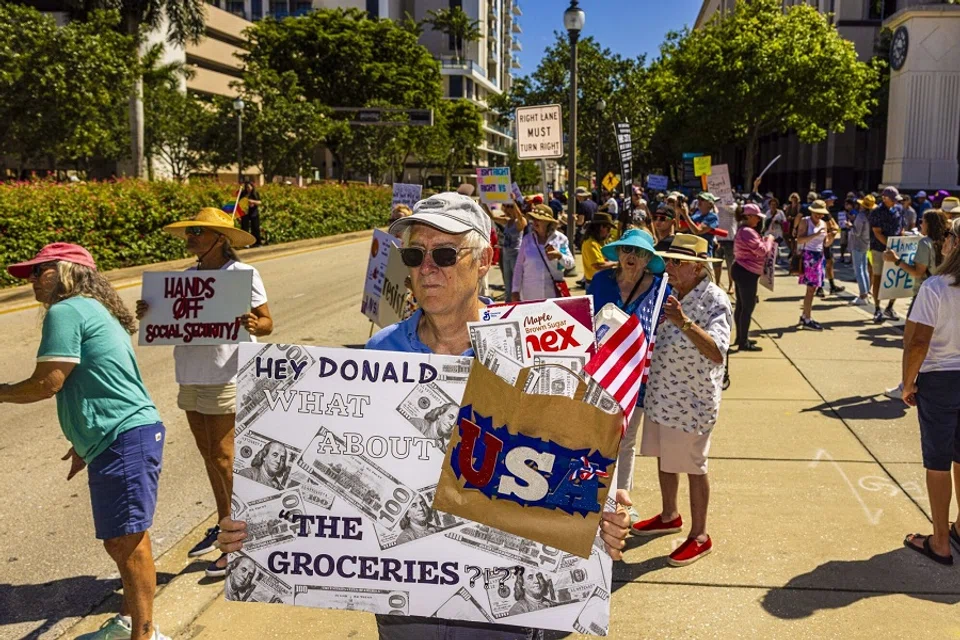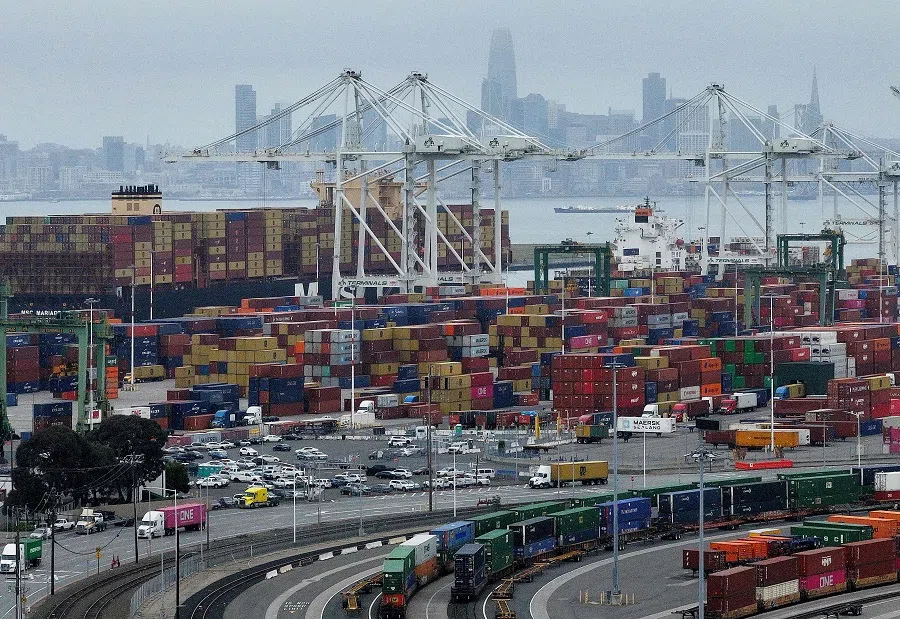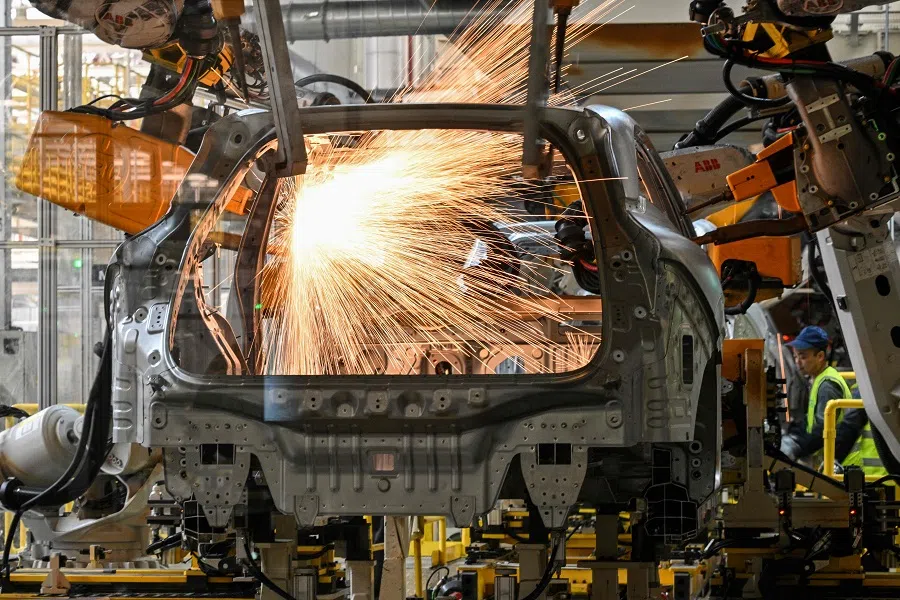The six big bets behind Trump’s tariff war
Is there a method to Trump’s tariff madness? There might be, according to Chinese academic Guo Bingyun and master’s student Chen Sirong, who discuss six possible objectives of Trump’s reciprocal tariffs.

US President Donald Trump’s newly announced reciprocal tariff policy has sent global shockwaves. While framed as an economic measure, we assess that these tariffs are strategically designed to achieve six core objectives, though their implementation may shift with political and market realities.
Reducing trade deficits
Firstly, Trump aims to reduce the US trade deficit and enhance fiscal revenue. The administration recognises that, given the current global supply chain structure and financial system, reducing the trade deficit is challenging, despite the necessity of a certain deficit level to maintain dollar hegemony.
However, Trump has repeatedly expressed his anger, asserting that the US is a victim of unfair trade. He stated, “For decades, our country has been looted, pillaged, raped and plundered by nations near and far, both friend and foe alike.” Such remarks were meant to provide a moral justification for his imposition of tariffs on other countries. However, Trump’s underlying goal is to secure more revenue to reduce the pressure on fiscal spending. He claimed that the new tariff policy is bringing in US$2 billion a day for the US and that the country is “doing very well”.

In recent years, the US federal government budget has been around US$7 trillion, with around US$2.5 trillion allocated for social security and health insurance, about US$850 billion for the military and roughly US$1 trillion for interest payments on national debt. The total fixed expenditure for these three items amounts to approximately US$4.5 trillion, leaving the federal government with only about US$2.5 trillion in discretionary funds.
... financial hegemony will eventually become unsustainable without long-term support from a corresponding manufacturing sector.
Protecting US industries and reviving manufacturing
Secondly, Trump hopes to protect US industries and facilitate the return of manufacturing. The media’s notion of the hollowing out of American manufacturing is primarily based on three sets of data: a decline in the share of the US’s global manufacturing value from 22% on the eve of the Cold War to about 15.1% today; a fall in figures for value added by manufacturing to US GDP from its peak of 28% to about 11% now; and a decrease in the number of US workers employed in the manufacturing industry from about 19.33 million in 1978 to approximately 13 million today. Yet the US accounts for roughly 4.2% of the world’s population, which means that when compared to the US population, the aforementioned data suggests that the manufacturing sector is not “hollowed out” but instead “solid”.
The fact that 80% of global trade is settled in US dollars shows that the dollar is the absolute cornerstone of America’s global hegemony. If dollar dominance were to diminish significantly, US global hegemony would collapse.
At the same time, manufacturing dominance underpins financial hegemony. While the latter can exist independently of a manufacturing base in the short term, financial hegemony will eventually become unsustainable without long-term support from a corresponding manufacturing sector. This is the fundamental reason why successive US administrations since the Barack Obama administration have been committed to manufacturing reshoring.
... the Trump administration hopes to “take advantage” of this window of opportunity to undermine China’s economy.

Prior to the rise of China’s manufacturing industry, the US was unaware of the importance and urgency of the matter. Today, China accounts for 30% of global manufacturing value added. If China’s manufacturing sector leads to the renminbi achieving a status commensurate with its share of global GDP, dollar dominance will be significantly weakened.
Containing China
Thirdly, Trump seeks to undermine China’s manufacturing industry and contain its rise. Since Trump’s first presidency, there has been a bipartisan consensus that China is the US’s biggest strategic competitor.
In 2024, China’s foreign trade accounted for a whopping 32% of its GDP. China’s various exports to the US accounted for about 15% of China’s total exports. Industry practitioners generally think that Trump’s 125% tariff on Chinese imports will impact China’s economic growth by 1.5 percentage points.
Since 2022, China’s total GDP has shown a decline in its share of both global and US GDP. China is now facing one of its biggest economic downturns since reform and opening up in 1978. Therefore, the Trump administration hopes to “take advantage” of this window of opportunity to undermine China’s economy.
Testing the waters
Fourthly, Trump hopes to test US leadership and prepare for the restructuring of the global trade order. On 2 April, Trump announced a reciprocal tariff policy initially targeting the world. Faced with China’s slew of strong countermeasures thereafter, Trump on 9 April announced a 90-day pause on all reciprocal tariffs except those imposed on China.
... a good experiment for the US to prepare for implementing other global policies aimed at isolating China in the future.

Within a week, over 70 countries have requested to negotiate with the US, including major strategically autonomous and populous countries like India, regional powers with populations exceeding 200 million like Indonesia, traditional US allies such as the UK, emerging market economies highly dependent on the US market like Vietnam, as well as with countries like Singapore, where the US has a goods trade surplus.
These countries, which “respect” the Trump administration, have fully demonstrated that despite being relatively weakened, the US remains a global hegemon that can still rally multitudes. This has provided a good experiment for the US to prepare for implementing other global policies aimed at isolating China in the future.
Reducing interest rates
Next, Trump wants to burst the US’s stock market bubble and force the Federal Reserve to reduce interest rates. The current US national debt has exceeded US$36 trillion, and the proportion of net interest expenses within fiscal spending continues to rise, highlighting the issue of fiscal deficits.
Meanwhile, the inflation problem triggered by persistent price increases has not been effectively resolved. The former Joe Biden administration’s failure to address this problem led to severe dissatisfaction among voters, which is the fundamental reason for Trump’s return to the White House.
Since his second term began, Trump has been hoping to burst the US’s stock market bubble and cause an economic recession to force the Federal Reserve to cut interest rates. But the Federal Reserve has refused to do so, citing high employment rates, a strong stock market, and solid economic growth as reasons not to.
Trump also hopes that under his leadership, the Republican Party can continue the strong momentum from last year’s presidential election into next year’s midterm elections.

After reciprocal tariffs were announced, the US stock market tumbled and wiped out several trillion dollars in market value. Trump responded, “I don’t want anything to go down, but sometimes you have to take medicine to fix something.”
Also, Trump insisted that tariffs will not cause inflation because they have a limited impact on prices. Instead, he argued that it was Biden’s misuse of subsidies that increased debt and fuelled an economic bubble. He also asserted that it was the Biden administration’s fault for allowing globalisation to let other countries take advantage of the US, which led to a loss of competitiveness for US products to some extent.
Consolidating power
Lastly, Trump desires to gain domestic political leverage and solidify the support of core voters. The biggest goal of any political party is to maintain long-term governance. Likewise, Trump also hopes that under his leadership, the Republican Party can continue the strong momentum from last year’s presidential election into next year’s midterm elections.
One of the goals of the reciprocal tariff policy is to secure the support from its core voters — blue-collar workers and the Rust Belt — who have high hopes for Trump’s America First policy and manufacturing reshoring plan. Trump firmly believes that tariffs can help raise funds for the US Treasury, protect American industries and attract factories to the US, thereby creating more jobs.






